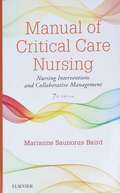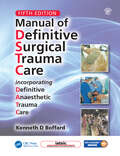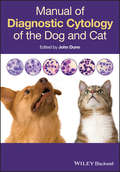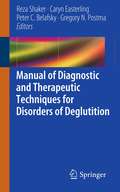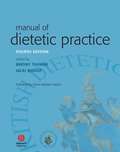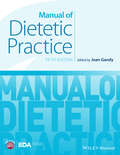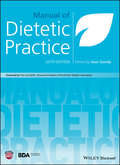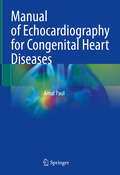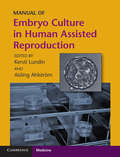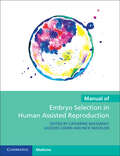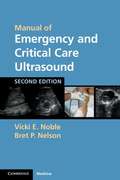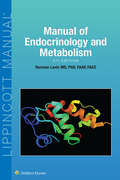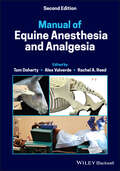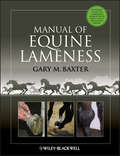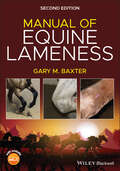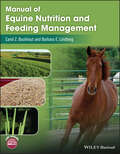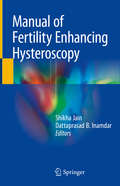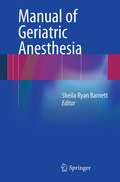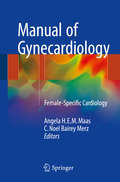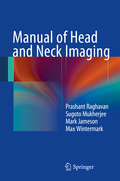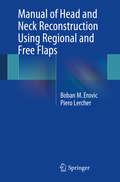- Table View
- List View
Manual of Cosmetic Surgery and Medicine: Volume 1 - Body Contouring Procedures
by Mohan Thomas James D’silvaThe most comprehensive cosmetic plastic surgery manual on body contouring surgeries explains in detail how to undertake body contouring procedures to remove excess fat deposits and sagging skin so as to improve the shape as well as the tone of the abdomen, back, thighs and other areas of the body, resulting in a body with smoother contours and providing an appropriate shape. It also describes the latest procedures including high definition and fine definition liposuction with the use of various technologies and body contouring after massive weight loss. It also contains chapters on important procedures of fat grafting along with live stem cells, and how they can only be harvested from the fat during liposuction. This surgical manual discusses all possible body contouring procedures in a step by step “How To” manner so as to help the novice Cosmetic Surgeon’s as well as seasoned and experienced Surgeon’s alike. The risks, complications along with pearls are discussed along with individual procedures with a series of step-by-step photographs and pre and post images and short video clips.This Manual in Cosmetic Surgery and Medicine sets the standard for doctors entering the field of aesthetic surgery and medicine. It is a reference book for people who are in practice as well as a step-by-step manual for students and young doctors wanting to pursue this field.The other volumes are on: • Rhinoplastic procedures• Intimate Genital procedures • Non-Invasive Aesthetic procedures• Breast reshaping• Cosmetic procedures of the Face
Manual of Critical Care Nursing: Nursing Interventions and Collaborative Management
by Marianne Saunorus BairdThe compact, yet comprehensive, Manual of Critical Care Nursing: Nursing Interventions and Collaborative Management, 7th Edition is your students’a go-to reference forto help you provide safe, high-quality nursing care in the clinicalcritical care settings. <p><p>Written in an abbreviated outline format, this easy-to-use Manual presents essential information on more than 75 disorders and conditions, as well as concepts relevant to caring for all critically ill patients and functioning in the critical care environment. Award-winning clinical nurse specialist Marianne Baird separates the content first by body system and then by disorder, with each disorder including a brief description of pathophysiology, assessment, diagnostic testing, collaborative management, nursing diagnoses, desired outcomes, nursing interventions, and patient teaching and rehabilitation. <p><p>With the latest NANDA-I nursing diagnoses and new sections on Bariatric Considerations and Caring for the Elderly, this practical manual is designed to help critical care nurses and nursing students better care for any critically ill patient.
Manual of Definitive Surgical Trauma Care, Fifth Edition
by Kenneth D BoffardDeveloped for the International Association for Trauma Surgery and Intensive Care (IATSIC), the Manual of Definitive Surgical Trauma Care 5e is ideal for training all surgeons who encounter major surgical trauma on an infrequent basis. This new edition includes both an e-version, and also a microSD card containing over 20 operative videos. The increasing role of non-operative management (NOM) has been recognised, and the Military Module is substantially updated to reflect recent conflict experience. An expanded section highlights trauma management under austere conditions.Written by faculty who teach the DSTC Course, this definitive and well established book focuses on life-saving surgical techniques to use in challenging and unfamiliar incidents of trauma.
Manual of Definitive Surgical Trauma Care: Incorporating Definitive Anaesthetic Trauma Care
by Kenneth D Boffard Jonathan Oliver WhiteDeveloped for the International Association for Trauma Surgery and Intensive Care (IATSIC), the Manual of Definitive Surgical Trauma Care 6e is ideal for training all surgeons and anaesthetists who manage trauma on an infrequent basis.The Manual is updated every 4 years and reflects the most recent developments in patient management based on new evidence-based information. Its focus is on the importance of the multidisciplinary care of the trauma surgical patient. This sixth edition has evolved, and the all-important section on the Non-Technical Skills which are required has been expanded. A significant number of the original guidelines in trauma have been archived, as they are no longer pertinent or have been superseded. The increasing (and occasionally harmful) role of non-operative management (NOM) has been recognized. The ‘Military Environments’ and ‘Austere Environments’ chapters have been substantially revised to reflect current multinational combat experience, and broadened to reflect modern asymmetrical conflicts and the increased need for humanitarian intervention including military peacekeeping in which only one side wears a uniform. Military weapons are used in major cities against the civilian population. More recently, urban, non-military populations have been the targets and victims of heavy military combat including use of ultra-sophisticated weaponry. Each situation carries its own spectrum of injury and responsibility of care.Including website access to a selection of videos which provide an anatomic overview of surgical approaches, this resource provides a gold standard educational and training resource to help prepare the relatively fully trained surgeon to manage the difficult injuries that might present to a major trauma centre.
Manual of Diagnostic Cytology of the Dog and Cat
by John DunnWish you could interpret cytological specimens in practice rather than paying a lab to do it for you? Want to provide your clients with a faster service?Manual of Diagnostic Cytology of the Dog and Cat is the ideal quick reference for the busy veterinarian in first opinion practice. It describes techniques for obtaining good quality cytological diagnostic specimens, and guides you through the interpretation of cytological findings.Created to be used alongside the microscope, hundreds of high quality colour photos will help you to identify normal cell types and abnormal cytology, including both non-neoplastic and neoplastic lesions. It describes in a clear and concise manner the most common lesions and related disorders encountered in a practice setting. The concise format means that you can quickly find exactly what you're looking for.Covering indications for cytological investigation, collection techniques and the evaluation and interpretation of findings, this concise manual will be your go-to resource.
Manual of Diagnostic and Therapeutic Techniques for Disorders of Deglutition
by Gregory N. Postma Reza Shaker Caryn Easterling Peter C. BelafskyManual of Diagnostic and Therapeutic Techniques for Disorders of Deglutition is the first in class comprehensive multidisciplinary text to encompass the entire field of deglutition. The book is designed to serve as a treasured reference of diagnostics and therapeutics for swallowing clinicians from such diverse backgrounds as gastroenterology, speech language pathology, otolaryngology, rehabilitation medicine, radiology and others. Manual of Diagnostic and Therapeutic Techniques for Disorders of Deglutition brings together up-to-date information on state-of-the-art diagnostic and therapeutic modalities form disciplines of gastroenterology, speech language pathology, otolaryngology and radiology through contributions of 28 innovators, and master clinicians for the benefit of patients and providers alike. It concisely organizes the wealth of knowledge that exists in each of the contributing disciplines into one comprehensive information platform. Manual of Diagnostic and Therapeutic Techniques for Disorders of Deglutition provides a one-stop destination for members of all specialties to obtain state-of-the-knowledge information on advanced diagnostic modalities and management. It is an essential reference for all deglutologists.
Manual of Dietetic Practice
by Briony Thomas Jacki BishopThe standard work for all those involved in the field of clinical nutrition and dietetics, The Manual of Dietetic Practice has been equipping health care professionals with the essential foundations on which to build expertise and specialist skill since it was first published in 1988. The fourth edition responds to the changing demand for multidisciplinary, patient-centred, evidence-based practice and has been expanded to include dedicated chapters covering adult nutrition, freelance dietetics, complementary and alternative therapies. Compiled from the knowledge of both individual experts and the British Dietetic Association's Specialist Groups, this truly is the essential guide to the principles of dietetics across its whole range.
Manual of Dietetic Practice
by Joan GandySince publication of its first edition, Manual of Dietetic Practice has remained an essential guide to the key principles of dietetics and a core text for healthcare professionals looking to develop their expertise and specialist skills. Published on behalf of the British Dietetic Association, the UK professional body for dietitians, it covers the entire dietetics curriculum and is also an ideal reference text for qualified practitioners.The book has been extensively restructured for its fifth edition and is now divided into two parts to make it easier to locate key topics. The first part covers professional practice, nutrition in specific groups, nutritional status and non-clinical areas of dietetic practices, while the second focuses on clinical dietetic practice, including nutrition support, and dietetic practice in individual areas of disease, from respiratory and renal disorders to mental health and palliative care. This edition also offers a companion website, www.manualofdieteticpractice.com, which includes case studies, discussion vignettes to place topics in a clinical context, downloadable copies of the appendices, key tables and figures, and references and useful links.
Manual of Dietetic Practice
by Joan GandyNow in its sixth edition, the bestselling Manual of Dietetic Practice has been thoroughly revised and updated to include the most recent developments and research on the topic. Published on behalf of the British Dietetic Association, this comprehensive resource covers the entire dietetics curriculum, and is an ideal reference text for healthcare professionals to develop their expertise and specialist skills in the realm of dietetic practice. <p><p> Written for dietitians, clinical nutritionists, and other healthcare professionals by leading dietitians and other professionals, the Manual of Dietetic Practice continues to provide a crucial resource for experts and novices alike.
Manual of Echocardiography for Congenital Heart Diseases
by Amal PaulThis book is a ready-reckoner which deals with the echocardiographic evaluation of congenital heart diseases (CHD). It has been prepared with the objective of enabling all echocardiographers, especially the ones who do not deal with CHD routinely, to perform a complete 2D echocardiographic study on patients with congenital cardiac anomalies of varying complexities. Anatomic variants and classifications of each anomaly are discussed in detail inorder to provide a broader perspective of the conditions being dealt with. Clinically relevant measurements and indices are covered to a great extent, equipping the examiner with all the necessary elements to prepare a complete final report. Special attention has been given to the evaluation of post-operative patients, who constitute the majority of adult CHD patients today. The book has been prepared in a concise manner, highlighting the most important points in each section. Most of the congenital cardiac anomalies have been dealt with comprehensively from the perspective of echocardiographic assessment. This manual provides all relevant details pertaining to the 2D echocardiographic diagnosis of congenital cardiac anomalies in a point-by-point format, which can come handy while dealing with complex cases, especially the rarer variants. This will be a valuable tool in the armour of every echocardiographer, including cardiologists, intensivists, anaesthetists, neonatologists, trainees, and interns.
Manual of Embryo Culture in Human Assisted Reproduction
by Kersti Lundin Aisling AhlströmWhilst assisted reproduction techniques (ART) have become increasingly successful and largely standardized, there is still only a partial understanding of what constitutes a 'true' embryo environment. Replicating the varying physiological conditions of the in-vivo environment that the embryo travels through in the in-vitro culture is still a major challenge in ART. This practical volume details how to organize and operate an IVF laboratory in order to mimic these conditions for successful embryo culture. Environments and equipment that are essential for running safe and efficient facilities such as maintaining good air quality and hygiene protocols, and utilizing an effective layout are covered in detail. Other chapters discuss the different consumables needed, optimal handling techniques and parameter monitoring systems, as well as recent advances in the area including artificial intelligence and automation. This is an indispensable guide to understanding the background science of culturing embryos, crucial to successful outcomes in ART.
Manual of Embryo Selection in Human Assisted Reproduction
by Catherine Racowsky Nick Macklon Jacques CohenSelecting the best embryo to transfer to the uterus is key to successful in vitro fertilization (IVF). A huge amount of research has been devoted to this topic and there are numerous methods used, from simple morphological assessment to molecular biological techniques to assess the genome and metabolism of the newly fertilized embryo. For many of these techniques, an adequate evidence base is lacking, and expert opinion is valuable. Clinical imperatives require ranking all embryos in a cohort according to their viability, thereby enabling the selection of the best embryo to optimize live birth outcome: a key indicator used to measure and rate IVF Clinics worldwide. This clear and informative manual will provide embryologists and clinicians with an overview of the tools now available to assist in embryo selection, as well as evidence for their efficacy and safety and the broader considerations that must underlie these important clinical decisions.
Manual of Emergency and Critical Care Ultrasound
by Vicki Noble Bret NelsonUltrasound has revolutionized a physician's ability to make urgent and emergent diagnoses at the bedside, and has changed the management of many acute injuries and conditions. This is a practical, concise introduction to what is rapidly becoming an essential tool for all critical care physicians: bedside emergency ultrasound. The Manual covers the full spectrum of conditions diagnosed using ultrasound and gives practical guidance in how to use ultrasound for common invasive procedures. Major applications are introduced using focused diagnostic questions and reviewing the image-acquisition skills needed to answer them. Images of positive and negative findings are presented, and scanning tips for improving image quality. The second edition has been substantially revised and expanded, with new images, updated literature reviews, new applications and clinical algorithms. New chapters cover additional procedures, musculoskeletal and pediatric applications, and the use of ultrasound in resuscitation. This text is invaluable for emergency physicians at all levels.
Manual of Endocrinology and Metabolism (Lippincott Manual Series)
by Norman LavinIdeal for all health care professionals who evaluate, diagnose, treat, or refer patients with endocrine disease or disorders, Manual of Endocrinology and Metabolism, Fifth Edition, brings together nearly 150 global authorities who share their knowledge and expertise on endocrine disorders in children, adolescents, and adults. Using a concise outline format, this thoroughly updated manual presents clinical information and protocols needed in everyday practice, with an emphasis on diagnosis and treatment. Succinct chapters and an abundance of tables and diagrams make complex information easy to find and understand.
Manual of Equine Anesthesia and Analgesia
by Tom Doherty Alex Valverde Rachel A. ReedA fully updated new edition of this practical guide to managing anesthesia in horses and other equids, providing updated and expanded information in a concise, easy-to-read format Manual of Equine Anesthesia and Analgesia provides practitioners and veterinary students with concise, highly practical guidance to anesthetizing horses, donkeys, and mules. Using a bulleted quick-reference format, this popular resource covers the basic physiological and pharmacological principles of anesthesia, patient preparation and monitoring, and the management of sedation and anesthesia. Chapters written by leading veterinary anesthesiologists contain numerous clinical images and illustrations, case examples, tables, diagrams, and boxed summaries of important points. Now in full color, the second edition features extensively revised and updated information throughout. New sections cover chronic pain, management of horses undergoing MRI, ventilators, nerve blocks for reproductive surgery, muscle relaxants, various new drugs, paravertebral anesthesia, treatment of pain using acupuncture and physical rehabilitation techniques, and more. Up-to-date appendices contain drug lists and dosages as well as equations related to equine cardiovascular and respiratory systems. This concise, easy-to-follow guide: Provides practical, clinically oriented information on anesthetizing equids Uses a bulleted format designed for fast access of key information Offers step-by-step instructions and diagrams of nerve blocks of the limbs, head, and ophthalmic structures Includes new coverage of topics including regulation of extracellular fluid and blood pressure, acid-base disorders, and hemodynamic effects of autonomic drugs Manual of Equine Anesthesia and Analgesia, Second Edition, remains a must-have resource for all equine practitioners and veterinary students involved with anesthetizing horses.
Manual of Equine Dermatology
by Dr Rosanna MarsellaThis book deals exclusively with the equine dermatological problems that the clinician would see in practice. It is the perfect reference for the practitioner who must quickly diagnose and treat the problems. Illustrated in color throughout, coverage progresses from the approach to a case which covers history, signalment, identification of primary vs secondary lesions, distribution of lesions, with examples of differential diagnoses based on the detection of specific lesions to therapy and to chapters of diseases organized by presenting problems and signs - pruritus, allergy, parasitic, crusting, nodules, ulcerative and regional. Over 90 color images together with tables and flow charts provide quick access to important diagnostic and treatment information.
Manual of Equine Lameness
by Gary M. BaxterManual of Equine Lameness provides essential information on equine lameness diagnostics and treatment in an easy-to-use format ideal for the clinical setting. A clinically relevant distillation of topics from Adams and Stashak's Lameness in Horses, this text offers a quick introduction and fast access to key information. An accompanying DVD includes practical supplements, including additional anatomical images, video clips demonstrating key procedures such as perineural and intrasynovial injections, and examples of lameness conditions in motion. Designed for use in daily practice, the book is presented in brief chapters carefully formatted to maximize the usefulness for practicing veterinarians. Manual of Equine Lameness is an invaluable resource to any veterinarian treating lameness in horses and an ideal reference for veterinary students wanting to learn the fundamentals of lameness.
Manual of Equine Lameness
by Gary M. BaxterMANUAL OF EQUINE LAMENESS Discover a concise and accessible guide to diagnosing and managing lameness in horses The revised Second Edition of Manual of Equine Lameness offers a concise and accessible manual of lameness diagnosis and treatment in horses. Perfect for use as a quick reference, this book provides straightforward access to the essentials of equine lameness, including the clinical assessment of the horse and commonly performed diagnostic nerve blocks and the most common conditions of the foot, forelimb, and hindlimb that may be contributing to the lameness. Current therapeutic options to treat lameness are also discussed, as well as guidance on how to manage musculoskeletal emergencies. The content has been distilled from the authoritative Seventh Edition of Adams and Stashak’s Lameness in Horses, and this new edition has been re-envisioned to be even quicker and easier to navigate than the previous version. Color photographs and illustrations support the text, which presents lameness information most relevant to equine general practitioners, mixed animal practitioners, and veterinary students. A companion website offers videos that focus on the clinical examination of the horse and select diagnostic blocks and relevant anatomy. Diagnostic and treatment material has been revised from the previous edition to include the most up-to-date information. Readers will find: A thorough introduction to the assessment of the lame horse, including history, visual exam, palpation, subjective and objective assessments of lameness, perineural anesthesia, and intrasynovial anesthesia An exploration of common conditions of the foot, including the navicular region and soft tissue injuries, coffin joint and distal phalanx conditions, and laminitis Discussions of the most common conditions of the forelimb, including the pastern, fetlock, metacarpus/metatarsus, carpus, antebrachium, elbow, and humerus, as well as the shoulder and scapula Discussions of common conditions of the hindlimb and axial skeleton A review of therapeutic options to treat lameness conditions How to manage musculoskeletal emergencies in the horse Ideal for veterinary students, early career equine practitioners, and mixed animal veterinarians, the Second Edition of Manual of Equine Lameness is an indispensable reference for any veterinarian seeking a concise one-stop reference for equine lameness.
Manual of Equine Nutrition and Feeding Management
by Carol Z. Buckhout Barbara E. LindbergManual of Equine Nutrition and Feeding ManagementS A practical manual for applied labs on the nutrition and feeding of horses In the Manual of Equine Nutrition and Feeding Management, a team of equine nutritionists and educators delivers a comprehensive manual perfect for use in an applied laboratory setting. This book explores critical ideas in equine nutrition, from plant identification to determining the cost of feeding. The laboratory concepts and assignments contained within this book combine the practical aspects of feeds and feeding with the technical aspects of equine nutrition. Each chapter is organized to include an introduction, objectives, and questions for further study; and is supplemented with additional activities to aid in the retention of the presented material. A companion website provides worksheets, with an instructor key with answers to the lab activities and assignments available to instructors. The book also includes: A thorough introduction to the equine digestive system, including the primary and secondary organs of digestion Comprehensive explorations of plant identification, pasture, hay, and concentrates for horses Practical discussions of by-product feeds and additives, including explanations of the concepts of “as sampled” and “dry matter” In-depth examinations of how to determine the nutrient content of feeds and the use of feeding standards and English-metric conversions Ideal for pre-veterinary and equine studies students, the Manual of Equine Nutrition and Feeding Management is also an indispensable resource for veterinary medicine and veterinary technician students, equine nutritionists, and the owners and breeders of horses.
Manual of Fast Track Recovery for Colorectal Surgery
by Nader Francis Robin H. Kennedy Monty G. Mythen Olle LjungqvistManual of Fast Track Recovery for Colorectal Surgery provides a broad overview on enhanced recovery, with expert opinions from leaders in the field regarding elements of enhanced recovery care that are generic and specific to colorectal surgery. This book covers the patient journey through such a programme, commencing with optimisation of the patient's condition, patient education and conditioning of their expectations. Manual of Fast Track Recovery for Colorectal Surgery investigates the metabolic response to surgery, anaesthetic contributions and optimal fluid management, after surgery. It also details examples of enhanced recovery pathways and practical tips on post-operative pain control, feeding, mobilisation and criteria for discharge. Manual of Fast Track Recovery for Colorectal Surgery is a valuable reference tool for colorectal surgeons, anaesthetists, ward nurses and other members of the team involved in perioperative care: pain control specialists, physiotherapists, dietitians, specialist therapists (such as colorectal and stoma nurses), and outpatient nurses.
Manual of Fertility Enhancing Hysteroscopy
by Shikha Jain Dattaprasad B. InamdarThis book is an illustrated and comprehensive compilation by experts in the field of fertility enhancing endoscopic surgery and assisted reproduction. This book catalogues full spectrum of diagnostic and operative hysteroscopy in the infertile population. The authors describe different techniques in various clinical conditions and review the recent evidence based literature supporting them. All procedures are explained in clear and precise text supplemented with high quality color pictures.
Manual of Geriatric Anesthesia
by Sheila Ryan BarnettThe Manual of Geriatric Anesthesia is a practical guide for physicians, residents, and students interested in the care of the elderly patient undergoing surgery. Although primarily written for anesthesiologists, other perioperative physicians and nurses will also find the information highly valuable. Highlights of the text include concise and clear discussions of preoperative assessment, anesthetic administration, the immediate postoperative care, as well as the more classic 'geriatric' topics such as the hip fracture patient, cataract surgery, postoperative delirium, dementia, ethics and end of life care. Clinical geriatric principles are woven into the text so that the reader can develop skills in geriatrics and develop a broader understanding of terminology and principles used in geriatric medicine.
Manual of Gynecardiology
by C. Noel Bairey Merz Angela H.E.M. MaasThis book provides a much-needed, internationally oriented text, focusing on specific aspects of heart disease in women. Despite the large amount of information available, there is still considerable confusion regarding female patients. As such, the book highlights the health events that occur during aging in women and that may influence the future CVD risk. For instance, pregnancy-related disorders are important predictors for CVD risk in women, and inflammatory diseases like rheumatic, thyroid disorders etc, which also interfere with CVD risk, are also more common in women. Adopting a multidisciplinary approach, including gynecology and endocrinology, it offers separate chapters on female-specific manifestations of ischemic heart disease, such as Tako Tsubo CMP and spontaneous coronary artery dissections. The book also discusses the effects and side effects of important medications. The chapters are clearly formatted, making it easy for readers to find subjects of interest.
Manual of Head and Neck Imaging
by Sugoto Mukherjee Max Wintermark Prashant Raghavan Mark J. JamesonThis book is designed as an easily readable manual that will be of great practical value for radiology and otolaryngology residents during their clinical rotations. Key facts on head and neck imaging are presented in short chapters written in an easily readable style. Line drawings are used to illustrate key concepts, and tables, checklists, and algorithms will enable the readers to arrive at a quick diagnosis. In addition, emphasis is placed on clinical pearls that will assist them in preparing suitable reports. The Manual of Head and Neck Imaging is sized to allow residents to read it completely within a matter of days, and it will also serve as an ideal quick reference guide as different clinical situations arise.
Manual of Head and Neck Reconstruction Using Regional and Free Flaps
by Boban M. Erovic Piero LercherAblative tumor surgery of the head and neck region often results in severe cosmetic and functional deformities. In these cases, microvascular free-tissue transfer enables three-dimensional reconstruction of head and neck defects. The selection of adequate donor tissue and a profound knowledge of the human anatomy and the various harvesting techniques are paramount in ensuring successful reconstruction. Reflecting current surgical approaches, this book presents the most frequently used flaps in head and neck surgery, including detailed overviews as well as their respective pearls and pitfalls. Moreover, each section contains a synopsis and pre-operative checklist. The overlay-technique merges high-quality-photographs with drawings and precisely illustrates the step-to-step descriptions of the different flap harvesting techniques, making this manual in pocket size an unique and accessible reference for both doctors in training and specialists in the field of otolaryngology, head and neck, plastic, maxillofacial and skull base surgery.

